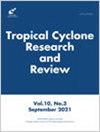利用卷积神经网络(cnn)、长短期记忆网络(LSTMs)和统计模型预测2025 - 2034年墨西哥尤卡坦半岛飓风的频率和强度
IF 4.1
4区 地球科学
Q3 METEOROLOGY & ATMOSPHERIC SCIENCES
引用次数: 0
摘要
气候变化大大增加了极端天气事件的频率和严重程度,这是联合国可持续发展目标13:气候行动所承认的趋势。本研究利用卷积神经网络(cnn)、长短期记忆网络(LSTMs)、自回归综合移动平均模型(ARIMA)和线性回归(LR)等先进计算模型,预测了墨西哥尤卡坦半岛2025-2034年的飓风活动。从国家飓风中心(NHC)保存的HURDAT2数据库中提取历史飓风数据,并在QGIS中进行空间分析,以评估风暴轨迹和风力强度。数据是用Python处理的,每个模型都经过训练,可以在三种风速类别下预测飓风的频率:50节、50 - 100节和100节。结果表明各模型的性能存在差异。CNN对低速事件表现出高变异性,2027年达到峰值4.21次,2034年降至1.27次。相比之下,LSTM和ARIMA保持稳定的预测,LSTM在2.7 - 3.0之间波动,ARIMA在1.5 - 1.8之间波动。在50-100节区间,CNN在2032年达到了8.14事件的异常高点,而LSTM和ARIMA则保持在较窄的区间(分别为1.85-2.01和1.32-1.99)。在>;100节高度,ARIMA从2025年的0.21上升到2034年的0.57,表明高强度气旋可能增加。这些发现强调了在气候变化条件下考虑非线性行为的自适应预报系统的必要性。模型输出为飓风多发地区尤卡坦半岛的风险管理、应急计划和基础设施复原力提供了有价值的见解。本文章由计算机程序翻译,如有差异,请以英文原文为准。
Forecasting the frequency and magnitude of hurricanes in the Yucatan Peninsula, Mexico, in the period from 2025 to 2034 using convolutional neural networks (CNNs), Long Short-Term Memory networks (LSTMs) and statistical models
Climate change has significantly increased the frequency and severity of extreme weather events, a trend recognized under the United Nations Sustainable Development Goal 13: Climate Action. This study forecasts hurricane activity in the Yucatan Peninsula, Mexico, for the period 2025–2034 using advanced computational models, including Convolutional Neural Networks (CNNs), Long Short-Term Memory networks (LSTMs), Autoregressive Integrated Moving Average models (ARIMA), and Linear Regression (LR). Historical hurricane data were extracted from the HURDAT2 database kept by the National Hurricane Center (NHC) and spatially analyzed in QGIS to assess storm trajectories and wind intensities.
The data were processed using Python, and each model was trained to predict hurricane frequency within three wind speed categories: <50 knots, 50–100 knots, and >100 knots. Results reveal divergent performance among the models. CNN exhibited high variability for low-speed events, peaking at 4.21 events in 2027 and dropping to 1.27 by 2034. In contrast, LSTM and ARIMA maintained stable forecasts: LSTM fluctuated between 2.7 and 3.0, and ARIMA ranged from 1.5 to 1.8. For the 50–100 knot range, CNN reached an anomalous high of 8.14 events in 2032, while LSTM and ARIMA remained within narrower bands (1.85–2.01 and 1.32–1.99, respectively). At the >100 knot level, ARIMA showed a rising trend from 0.21 in 2025 to 0.57 in 2034, suggesting a potential increase in high-intensity cyclones.
These findings emphasize the need for adaptive forecasting systems that account for nonlinear behavior under climate change conditions.
The model outputs offer valuable insights for risk management, contingency planning, and infrastructure resilience in the hurricane-prone Yucatan Peninsula.
求助全文
通过发布文献求助,成功后即可免费获取论文全文。
去求助
来源期刊

Tropical Cyclone Research and Review
METEOROLOGY & ATMOSPHERIC SCIENCES-
CiteScore
4.60
自引率
3.40%
发文量
184
审稿时长
30 weeks
期刊介绍:
Tropical Cyclone Research and Review is an international journal focusing on tropical cyclone monitoring, forecasting, and research as well as associated hydrological effects and disaster risk reduction. This journal is edited and published by the ESCAP/WMO Typhoon Committee (TC) and the Shanghai Typhoon Institute of the China Meteorology Administration (STI/CMA). Contributions from all tropical cyclone basins are welcome.
Scope of the journal includes:
• Reviews of tropical cyclones exhibiting unusual characteristics or behavior or resulting in disastrous impacts on Typhoon Committee Members and other regional WMO bodies
• Advances in applied and basic tropical cyclone research or technology to improve tropical cyclone forecasts and warnings
• Basic theoretical studies of tropical cyclones
• Event reports, compelling images, and topic review reports of tropical cyclones
• Impacts, risk assessments, and risk management techniques related to tropical cyclones
 求助内容:
求助内容: 应助结果提醒方式:
应助结果提醒方式:


